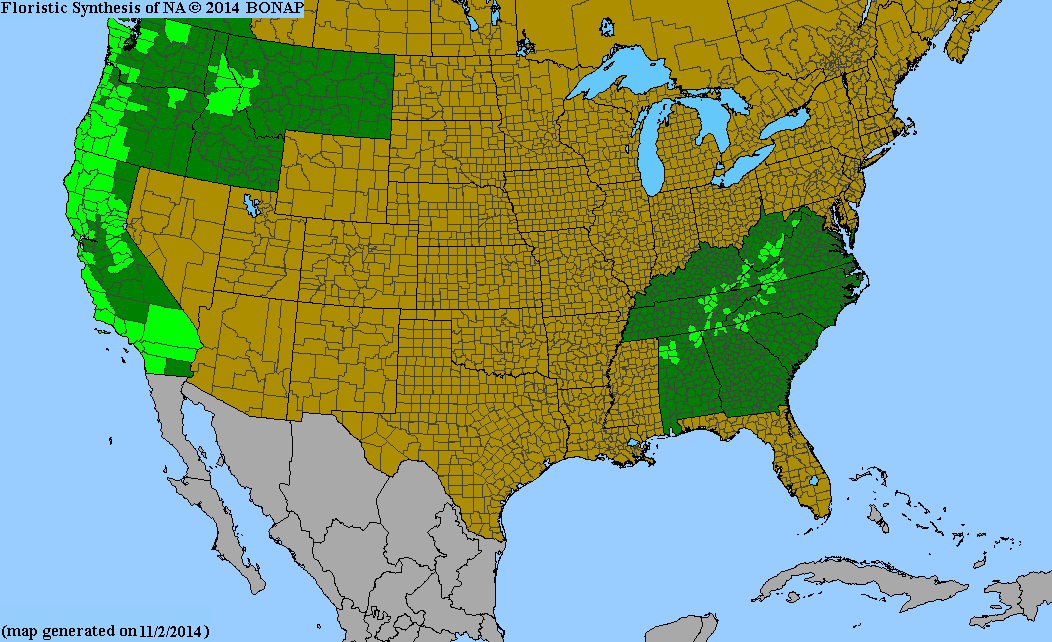Anyway, I was researching Liatris species for my last article, and I discovered that the plant I most likely saw. Liatris ligulistylis, is restricted to nine counties in Illinois, out of the sixty-odd counties here. The discovery of an uncommon species of plant is always a joy, and that got me thinking. Owing to research I've done online for blog articles,(what, do you think I know all those scientific names by heart?) I've discovered several plants that are fairly rare or uncommon. I also once figured out that I found a baby box turtle as opposed to a snapping turtle whilst doing research for that article. Then I did the same thing researching yuccas for my Line Creek post. This happens a lot, and as such there are a few stories.
I mentioned Canada mayflower, Maianthemum canadense, in a previous article. It ranges as far south as Starved Rock State Park in Utica, Illinois. There are a pair of similar species native throughout Illinois with similar looks, only much larger. Here's one of them, taken at Starved Rock:
And here's what I suspect to be the Canada mayflower, taken in a different area on the same trail. It was a much shorter plant, but blooming at the same time and had only two leaves, like Canada Mayflower generally does. Apparently, I saw it, took a blurry picture, and then ran off to photograph a nearby beetle. Still, you get the general idea. This was just identified yesterday, actually. It's quite exciting for a plant nerd like me to find out he's found a rare plant like this, sort of by accident. In the excitement of the day, sometimes the rarest plants go unnoticed. I have to wonder how many plants I don't photograph.
Similarly, I was hiking in Giant City State Park in southern Illinois when I spotted the following plants.
This is apparently the leaves of American Columbo (Frasera caroliniensis), an unusual Illinois species of dry upland forests. It is the only Frasera species to live on this side of the Mississippi River. Most of its cousins live in the Rockies, and I actually had the luck to see one of those on top of a mountain in the Tetons. Here are pictures of that plant, likely Frasera speciosa.
I was reading on Blue Jay Barrens' old articles when I ran across the leaves of this plant. (Blue Jay Barrens is an awesome blog run by Steve Willson, who owns said barrens in Southern Ohio. I have it in my blogs tab to the right, not that I need to since about three-quarters of my visitors seem to come from that blog to mine.) Then I double checked my pictures, and found out that I had seen this plant. While not a particularly rare plant, Frasera caroliniensis is not a plant I had ever seen before. Thanks, Steve Willson!
Perhaps the best story is of this plant:
I took a picture of it while hiking next to a waterfall in Dupont State Forest in North Carolina. The area is full of waterfalls, and so I was focused more on them than on plants. This was also the place where I found my first Indian-Pipe plants, (Monotropa uniflora), so I had a lot of other interests than just some random white flowers growing in a crack in the rock. However, a previous vacation shed some light on what they were. I went to Yosemite National Park many, many years ago. While in the vicinity of Bridalveil Falls, I spotted a small, white flower growing in the leaves. I have no idea what it is. Here it is, however. If you have a clue as to its identity, please let me know.
Operating under the theory that this might be a member of the Western U.S. genus Boykinia, I searched Boykinia on BONAP and came up with this:

I had believed that Boykinias were only native to the West Coast, so what was this map doing showing one ranging out east? I looked up the easterner, Boykinia aconitifolia, commonly known as Allegheny Brookfoam. Well, I still didn't have an answer as to what my Yosemite plant was, and I still don't. However, my Dupont State Forest plant was Boykinia aconitifolia, the only eastern species of a West Coast-centered genus of plants. Furthermore, it's a highly uncommon plant, even in North Carolina. It is a threatened species, in fact.
Now I know that most people are like, "Yay, he found a plant. I don't care." I know at least one reader of this blog holds that view. I understand that. But to me, this was really a unique discovery. By going west, I went east, and found a plant I had never seen before and may never see again. I would never have done it if I hadn't been considering asking people for help about the Yosemite plant (which I just did, by the way.) Thanks to researching articles for this blog, I have learned much more than if I had just let those pictures sit and never looked them up. Thanks to this blog, I have gotten to learn more about nature. Isn't that the point?






Hi, Jared. Many of the plant identifications I've done on my property have been the result of my seeing a plant photo and having it remind me of something I once saw but didn't ID. It's always a thrill when that happens. I've been enjoying your blog.
ReplyDeleteThanks! I've been enjoying yours as well.
ReplyDelete